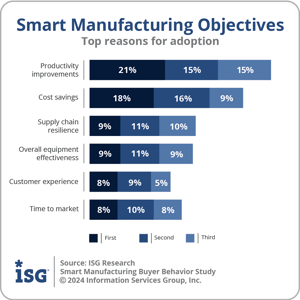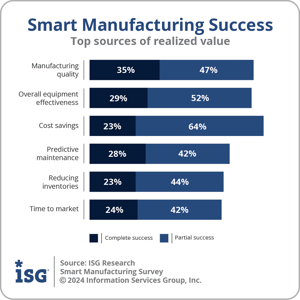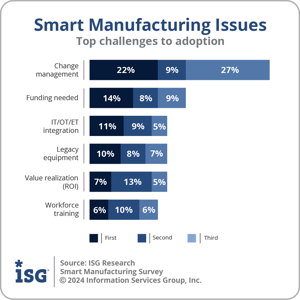Smart manufacturing is a strategic operating approach that aligns advanced manufacturing technology with system and process design principles to promote adaptability. It is a digital, event-driven, collaborative orchestration of physical and digital processes designed to increase productivity, efficiency, adaptability and resilience. These systems use technologies to coordinate the planning and execution of even disparate operations within factories and across an entire manufacturing supply chain.
Smart manufacturing emerged in the early 2000s as a unifying term highlighting the confluence of established digital manufacturing technologies with those that were emerging. The former included computer-aided design and drafting and computer-integrated manufacturing, while the latter focused on additive manufacturing, digital twins and increasingly advanced software. More recently, the rapid advance of artificial intelligence and generative AI has accelerated the impact of smart manufacturing by improving planning accuracy, streamlining processes and reducing frictions to promote productivity.
The former included computer-aided design and drafting and computer-integrated manufacturing, while the latter focused on additive manufacturing, digital twins and increasingly advanced software. More recently, the rapid advance of artificial intelligence and generative AI has accelerated the impact of smart manufacturing by improving planning accuracy, streamlining processes and reducing frictions to promote productivity.
ISG Research conducted an in-depth study on the objectives, status and issues related to smart manufacturing. For decades, there’s been an expectation that technology can drive step-function improvements in the speed, cost and quality of manufactured goods. From my perspective, a consistent theme has been how long it takes for reality to achieve what is envisioned. Technology diffusion in manufacturing takes time, but the good news is that decades of advances have been culminating in progress.
The research looked into the reasons why enterprises want to adopt smart manufacturing and found that economics was the prime motivation. Half of the participants chose productivity improvements as the first, second or third most important reason to adopt smart manufacturing, while 43% cited cost savings. The two are aligned, but productivity focuses on achieving greater throughput, improved quality, higher sales from existing assets or channels and greater profitability. They also are directly aligned to achieving better financial metrics.
Participants in the research also provided insight into where their enterprise had achieved value from smart manufacturing initiatives. While no more than about one-third qualified their efforts as a complete success, most indicated they had at least achieved complete or partial success. These include manufacturing quality improvement (82%), overall equipment effectiveness (81%), predictive maintenance (69%), time-to-market reductions (66%), cost savings (88%) and inventory reduction (67%). In other words, at least some gains in productivity and cost savings have been achieved, although more are possible.
their efforts as a complete success, most indicated they had at least achieved complete or partial success. These include manufacturing quality improvement (82%), overall equipment effectiveness (81%), predictive maintenance (69%), time-to-market reductions (66%), cost savings (88%) and inventory reduction (67%). In other words, at least some gains in productivity and cost savings have been achieved, although more are possible.
Supply chain resilience and overall equipment effectiveness were both listed by 29% of participants as ways organizations had achieved better operational performance. Resilience became top of mind when pandemic lockdowns created waves of ructions in operations and supply chain management but was already gaining in importance before 2020.
On the supply chain front, the once-benign trade environment that enabled a singular focus on the lowest cost began eroding in the ‘teens, and this negative trend will continue to be a challenge, especially for enterprises with long supply chains and global exposure.
Supply chain issues may have slipped from the headlines, but they remain a source of vulnerability. Overall equipment effectiveness is a score for measuring manufacturing productivity–the percentage of time that the equipment is truly productive. An OEE of 100% indicates that an organization is operating at full daily capacity with no scrap. Smart manufacturing’s inherent methodology is designed to enable higher throughput with better quality.
As much potential as there is with smart manufacturing, there are also challenges. Manufacturing organizations are notoriously reluctant to take up new digital technology. When asked about their organization’s top three challenges in adopting or advancing smart manufacturing initiatives, a wide margin of research participants cited change management. A full 57% of participants ranked this first, second or third.
When asked about their organization’s top three challenges in adopting or advancing smart manufacturing initiatives, a wide margin of research participants cited change management. A full 57% of participants ranked this first, second or third.
Addressing workforce resistance to adopting new methods has been a constant in the digital age, and there are no magic bullets to deal with it. Both the tone at the top and the tone from middle management are key elements for dealing with it. It is helpful if there is an organizational culture open to continuous improvement. Allocating sufficient resources for training, tracking progress toward goals and celebrating are also necessary.
Insufficient funding for smart manufacturing initiatives is related to the difficulty in value realization or return on investment. Pulling together the integration of operational and IT systems is an impediment, especially where there are non-digital legacy systems that cannot be easily integrated with IT systems, if at all. And there is an issue of workforce training on smart systems, which goes back to dealing with change management.
Artificial intelligence, both predictive and generative, will benefit the implementation and management of smart manufacturing systems. ISG-Ventana Research asserts that by 2027, at least one-half of smart manufacturing efforts will involve AI for operations and planning to improve quality and productivity. There are a wide variety of use cases, including more accurate predictive maintenance that reduces downtime and costs, more effective and agile planning, better quality control through the management of quality assurance processes and more effective supply chain management.
least one-half of smart manufacturing efforts will involve AI for operations and planning to improve quality and productivity. There are a wide variety of use cases, including more accurate predictive maintenance that reduces downtime and costs, more effective and agile planning, better quality control through the management of quality assurance processes and more effective supply chain management.
The technology can help reduce technical debt in systems, addressing the issue of melding operational and information technology. However, it’s likely that having the right data at the right time will be a major issue confronting all users of AI, especially in acquiring and using external data. This is important for forecasting and planning as well as for operations.
In the case of predictive maintenance, an algorithm that uses machine temperature sensors to assess the health of the asset must also consider the ambient temperature to avoid inaccuracies since the condition may be caused by a summer heat wave rather than excessive friction. That noted, an important but largely unremarked challenge for AI is cost. Some initiatives will have obvious near-term economic benefits, but not all.
I recommend that all manufacturing organizations focus on implementing or enhancing existing smart manufacturing methods. Not all initiatives can be funded, but becoming smarter about the business case for investing helps those who have struggled to successfully gain funding in the past. AI is likely to alter the economics of smart manufacturing efforts, making them more attractive through greater productivity and reduced operational friction. However, success in applying AI will be contingent on data quality and availability, so careful attention should be paid now to achieving this foundation. Smart manufacturing can sound like a buzzword, but the underlying concepts are practical and consistent with what, from the beginning of time, it takes to be successful making anything.
Regards,
Robert Kugel
 The former included computer-aided design and drafting and computer-integrated manufacturing, while the latter focused on additive manufacturing, digital twins and increasingly advanced software. More recently, the rapid advance of artificial intelligence and generative AI has accelerated the impact of smart manufacturing by improving planning accuracy, streamlining processes and reducing frictions to promote productivity.
The former included computer-aided design and drafting and computer-integrated manufacturing, while the latter focused on additive manufacturing, digital twins and increasingly advanced software. More recently, the rapid advance of artificial intelligence and generative AI has accelerated the impact of smart manufacturing by improving planning accuracy, streamlining processes and reducing frictions to promote productivity. their efforts as a complete success, most indicated they had at least achieved complete or partial success. These include manufacturing quality improvement (82%), overall equipment effectiveness (81%), predictive maintenance (69%), time-to-market reductions (66%), cost savings (88%) and inventory reduction (67%). In other words, at least some gains in productivity and cost savings have been achieved, although more are possible.
their efforts as a complete success, most indicated they had at least achieved complete or partial success. These include manufacturing quality improvement (82%), overall equipment effectiveness (81%), predictive maintenance (69%), time-to-market reductions (66%), cost savings (88%) and inventory reduction (67%). In other words, at least some gains in productivity and cost savings have been achieved, although more are possible. When asked about their organization’s top three challenges in adopting or advancing smart manufacturing initiatives, a wide margin of research participants cited change management. A full 57% of participants ranked this first, second or third.
When asked about their organization’s top three challenges in adopting or advancing smart manufacturing initiatives, a wide margin of research participants cited change management. A full 57% of participants ranked this first, second or third.  least one-half of smart manufacturing efforts will involve AI for operations and planning to improve quality and productivity. There are a wide variety of use cases, including more accurate predictive maintenance that reduces downtime and costs,
least one-half of smart manufacturing efforts will involve AI for operations and planning to improve quality and productivity. There are a wide variety of use cases, including more accurate predictive maintenance that reduces downtime and costs, 








